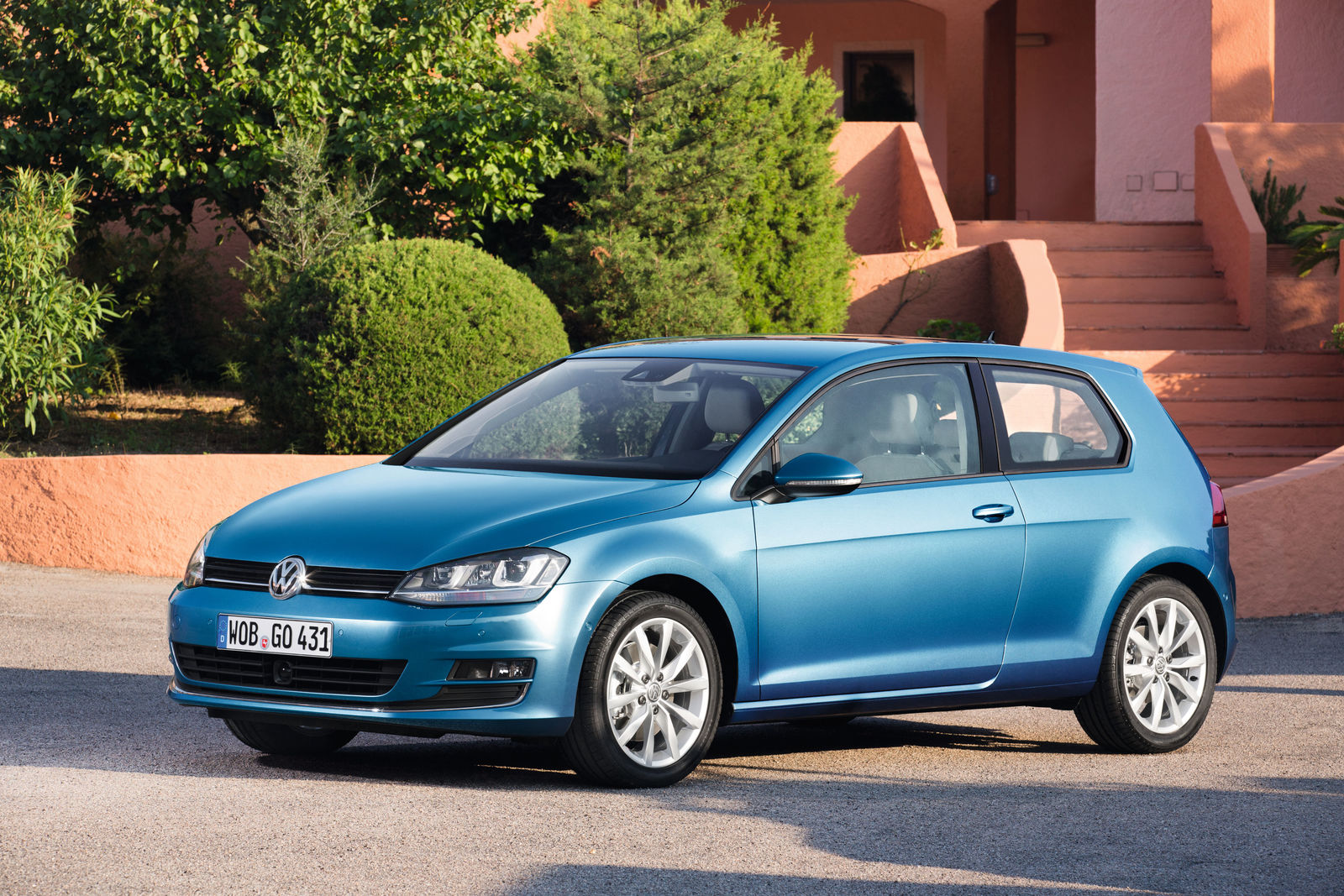The new Golf. Das Auto. International Driving Presentation
Contains 10 sections: Styling, Engineering, Interior, Infotainment systems, Standard and optional features, Innovations, Powertrain structure, Running gear, Retrospective, Overview
The new Golf. - Body I – styling
Golf exterior one of the world's most recognisable product designsSeventh stage of Golf evolution clearly shows added dynamism and precisionGolf reflects par excellence the principles of Volkswagen design DNA
There is but a handful of cars with a design that, like the Golf's, has been constantly refined, tweaked and enhanced down the decades and has thus become timeless. In this process, Volkswagen designers repeatedly gave a new edge to the Golf's product features. These include the typical C-pillars, the long roofline and the characteristic front and rear sections. These details also make the new Golf more independent, sophisticated and durable than any other compact car.
The design of the new Golf
In developing the new Golf, the teams led by head designers Walter de Silva (Group) and Klaus Bischoff (Brand) based their work on a great deal of creative freedom that allows many different approaches for a new design, while also focusing on the principles of the Volkswagen design DNA. A look at this DNA reveals the key to the new Golf's design.
Development of the DNA. Over recent years, the Volkswagen designers have crystallised a selection of core elements from the brand's history, which they term its ‘historic DNA'. All current Volkswagen designs correspond to this DNA, with the cars therefore conveying a modern, progressive impression, which nevertheless – and this is the key – feels familiar. This DNA includes elements such as the reduced form of the radiator grille crossbeam, the look of the side windows as well as the first Golf's roofline and the Golf Mk4's typical C-pillars and wheel arches.
This DNA creates a unique, unmistakable language of product features and design. The language of product features leaves a familiar feeling, and yet it creates a new sensation in the eyes of the observer. The features are visual characteristics such as functionality, robustness, honesty and reliability. These characteristics are generated by a language of form perfected over many years. It creates the typical Volkswagen product design that today enjoys success around the globe.
Premium proportions. "This language of form," explains Bischoff, "is logical, solid, product-focused, pure and precise, and it reflects the brand's design DNA as a perfect model of creativity. This makes the base architecture of the new Golf unmistakable. It comes over as simple, strong, understandable, reliable and safe. When one begins with the pure element of this clear base architecture, details such as the economical use and placement of sculptural lines seem more like fine nuances. Another extremely important point is that the Golf's proportions have completely changed with the seventh generation, making the car look more confident than ever before!"
Marc Lichte, lead exterior designer, explains: "The proportions have changed, as we have taken advantage of the Modular Transverse Matrix here. The front wheels, for example, have moved 43 millimetres further forward. The front overhang is therefore shorter, while the bonnet looks longer." Klaus Bischoff confirms this: "Visually, the passenger compartment has been shifted towards the rear, creating what is called a ‘cab backward' impression. That's what we call the proportions of premium-class vehicles, where the bonnet is long and the passenger compartment a long way towards the back. On the new Golf, we thus have proportions that you otherwise only get in higher-class segments of the market."
Side profile has powerful lines. Marc Lichte: "And we sought to emphasise these modified proportions with design elements. Below the door handles, we have integrated the now clearly visible and very sharp character line. While this line is interrupted by the wheel arches, it is otherwise continuous and is stylistically reflected in the chrome bars of the radiator grille and headlights and at the back in the white lateral bars of the rear light clusters. Set deep down all the way around, this line lowers the visual centre of gravity and gives the car a more solid stance on the road. Another striking element is the new line along the side shoulder directly below the windows. This line begins at the front in the headlight, and then glides under the wing mirror, which is positioned right on the line, all the way through to the rear side window, underscoring the premium proportions of the new Golf." The wheel arches are particularly prominent as well, and along with the wider track, longer wheelbase and tyre dimensions of up to 18 inches, they make the Golf appear more powerful.
"Two other features," explains Klaus Bischoff, "are characteristic of the new Golf silhouette: the C-pillar and the roofline. On the previous Golf, the character line still cut through the C-pillar. This is no longer the case on the new Golf. The C-pillar runs along one homogenous surface from the start of the roof all the way to the rear wheel arch. Above the wheel arch, however, it picks up more strongly the entire width of the car – and as a result, when viewed from behind or diagonally from the rear, the new Golf looks more solid and powerful. Viewed from the side, the precision of the C-pillar design catches the eye; it resembles the drawn string of a bow, giving the Golf a look of acceleration even while it is standing still. At the same time, it pays homage to the Golf Mk1 and Mk4 – both design icons." On the right-hand side of the vehicle, even the shape of the fuel cap is integrated into this arrow element. Head Designer Klaus Bischoff continues: "The contour of the roofline has also been completely redesigned. Here – above the side windows – the Golf now displays another line, which runs from the roof-edge spoiler right through to the A-pillars. It is one of those character features that give the Golf a particularly sophisticated look from the side as well – a line that at first glance may remain unnoticed, yet is a further detail en route to visual precision."
Front section. The Volkswagen design DNA manifests itself in a ‘face' that has appealing features. In addition, in the same way as on the first Golf, it defines horizontally balanced elements that create a certain width. Together they produce a front section that is recognisable in every rear view window as that of a Volkswagen. Each Volkswagen class has its own character attributes in this respect. In the Golf class these include, for example, the slightly upward sweeping headlights and a defined maximum height for the radiator grille.
Compared to its predecessor, the new Golf displays completely restructured modulation of its surfaces. While on the Golf Mk6 the wings were higher than the bonnet – effectively framing it – this is now the other way round. On the sides, the crease lines form the wings' lowest points, before the latter transition vertically into the wheel arches. The top border of the wings is formed by a line, as if cut by a knife, which begins at the A-pillars. All of the lines together form a V-shaped bonnet.
Beneath the bonnet come the redesigned headlights and the comparatively narrow band of the radiator grille. At the bottom, the radiator grille is bordered – to the left and right of the chrome VW badge – by a chrome bar, which in the case of fitting with xenon headlights is continued in the headlight housing. Particularly striking are the LED daytime running lights of the xenon headlights. Meanwhile the bottom air inlet, in conjunction with the body-coloured area beneath the headlights, supports the strong horizontal layout of the front section design. The air inlet is now framed by a body-coloured area that even with the car's very confident look gives it the typical Volkswagen smile. Another core design element is the bend at the outer ends of the bumper, which produces – especially in a top view – an alternation of shapes.
Rear section. Typical Golf elements at the rear include the clear geometry of the rear lights, the rear window stretching all the way to the C-pillars and the large uniform surface around the Volkswagen badge. Iconic: even without the badge or model name the seventh generation of this best-seller is instantly recognisable as a Golf. And yet every line is new. That applies both to the rear light clusters that terminate narrower on the inside and terminate parallel to the C-pillar on the outside (with striking L-shaped light contours) and to the tailgate, which reaches much lower down and offers the lowest boot sill height in its class (665 mm). A horizontal light-refracting edge near the bottom of the tailgate, which continues on the bumper, and the boot sill running parallel below this emphasise the sportily full width of the new Golf. These elements also correspond to the lines of the now much more pronounced bumper that is visually "pulled out" towards the rear. The bumper itself is fully painted right down to the bottom, with only the centrally integrated diffuser, which also incorporates the exhaust pipe, kept black.
Notes:
TDI, TSI, DSG and Twincharger are registered trademarks of Volkswagen AG or other companies of the Volkswagen Group in Germany and other countries.
Features and technical data apply to models offered in Germany. They may differ in other countries. All fuel consumption and CO2 emissions data cited in this press kit refer to official vehicle registration values (combined values), which were determined under standard conditions in the NEDC cycle. Fuel consumption and CO2 emissions values for the Golf 1.4 TSI with ACT (103 kW / 140 PS) and the Golf BlueMotion 1.6 TDI (81 kW / 110 PS) are forecast values as of September 2012.
Media contact

